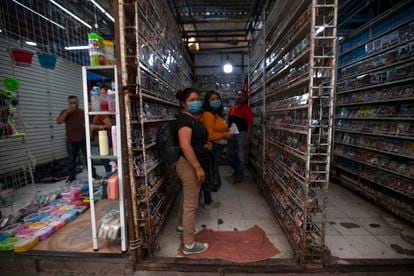Street vendors in the Tepito neighborhood of Mexico City, in April 2020.Monica Gonzalez / EL PAIS
The coronavirus crisis has left Mexico with fewer and worse jobs. One year after the start of the pandemic, there are still 2.1 million jobs to recover, according to data published this Monday by the National Institute of Statistics and Geography (Inegi) for the first quarter of the year. Women have gotten the worst of it; they represent 71% of those who have not yet returned to work. Furthermore, the economic recovery has come at the cost of an increase in precariousness. 13.8% of the population is available to work longer hours, compared to 8.4% a year ago.
If one compares the current moment with the hardest months of confinement, the rebound is clear. Of the approximately 12 million jobs destroyed during the onset of the pandemic, the vast majority have been recovered thanks to the reopening of the industry and the gradual lifting of restrictions. However, in the first quarter of the year, the active population, which is employed or looking for a job, registered a decrease of 1.6 million people, that is, some workers have chosen to leave the labor market. In parallel, the employed population experiences a similar reduction, from 55.1 to 53 million people.
The plateau on which the recovery is located already has a “structural” tinge, according to the economist José Luis de la Cruz.
“After the reopening and reactivation process from August to December, the start of 2021 confirms that there is no substantial improvement in terms of job creation and quality.
The precariousness of the market remains at the levels of three months ago ”, says the expert.
More information
Mexico recovers 80% of the jobs lost by the pandemic at the cost of more precariousness
The coronavirus crisis uncovers the vulnerability of thousands of unemployed in Mexico
Some 12 million people stopped working in Mexico during April
The crisis has hit women more than men. They represent seven out of every 10 unemployed. Of the 2.1 million jobs that have not been recovered, 1.5 million correspond to women and only 604,000 to men. School closures have forced many mothers, who carry the burden of household chores, to stay home with their children, delaying their return to the job market.
The gender gap is also explained by the decline in the service sector, the traditional bridge to female employment. Despite the Easter holidays and the modest recovery in tourism, the hotel industry registered 656,000 fewer people than a year ago and businesses, 712,000 less. By size, the businesses that report the greatest impact are those that employ less than 10 people, with a decrease of 924,000 jobs. Of these, 825,000 correspond to women and 99,000 to men.
The threat of a two-speed revival is real, says De la Cruz. “The micro-business had been the mechanism for women to be able to enter the labor market. If the measures are not taken to promote the domestic market, the inequality gap will open because a recovery is being observed in the export sectors, and the T-Mec legal framework imposes that it be improved, while the others are lagging behind. ”, Says the economist.
Quintana Roo, with an unemployment rate of 8.2%, is the most affected state. Its dependence on the tourism sector, which plummeted 46% in 2020, has taken its toll. The Caribbean region is followed by Mexico City, with 7.3% unemployment, and the State of Mexico, with 6.5%. It is not by chance either. They are the two entities hardest hit by infections and deaths from covid-19.
Precariousness is another of the consequences of the crisis. The underemployed people, those who would be willing to work longer hours, have increased from 4.6 million in the first quarter of 2020 to 7.3 million in the first three months of 2021; an increase of 2.7 million people. There are other signs that confirm the trend. People who work more than 48 hours a week have gone from representing 26.9% of the employed population to 25.9%, while those who work less than 15 hours have risen from 6% to 6.7%.
After suffering an 8.5% drop in GDP in 2020, the largest since the 1930s, the economy grew 0.4% during the first quarter of the year compared to the previous quarter, pointing to a slowdown of reactivation.
In the last months of last year, GDP had advanced 3.3% compared to the previous period.
Subscribe here
to the
newsletter
of EL PAÍS México and receive all the informative keys of the current situation of this country


/cloudfront-eu-central-1.images.arcpublishing.com/prisa/EMYXC3EVHNEG3OJHGIQCB2IVYA.jpg)

/cloudfront-eu-central-1.images.arcpublishing.com/prisa/4PKPLHZOXBG5TEAQ6JNDTUJXBA.jpg)



